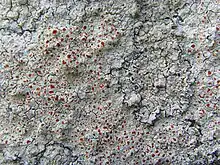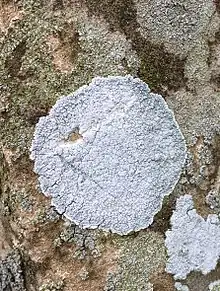Haematomma ochroleucum
Haematomma ochroleucum, also known as yellow bloodstain lichen, is a species of crustose lichenized fungus. First described in 1771 by Noël Martin Joseph de Necker, it has no subspecies, but two named varieties: H. o. var. ochroleucum and H. o. var. porphyrium.
| Haematomma ochroleucum | |
|---|---|
 | |
| Scientific classification | |
| Domain: | Eukaryota |
| Kingdom: | Fungi |
| Division: | Ascomycota |
| Class: | Lecanoromycetes |
| Order: | Lecanorales |
| Family: | Haematommataceae |
| Genus: | Haematomma |
| Species: | H. ochroleucum |
| Binomial name | |
| Haematomma ochroleucum (Neck.) Laundon, 1970 | |
| Synonyms[1] | |
|
Lichen ochroleucus Neck., 1771 | |
Taxonomy
Belgian botanist Noël Martin Joseph de Necker first described Haematomma ochroleucum in 1771 from a type specimen collected from shaded rocks in the Rheinland-Pfalz region of Germany.[1][2] He named it Lichen ochroleucus. When Jack Laundon moved the species to the genus Haematomma in 1970, he created the combination Haematomma ochroleucum to replace the illegitimately named Haematomma coccineum. The latter name had been given to a later description of the same species, and had gained widespread usage; however, Necker's name took taxonomic precedence.[1] Haematomma ochroleucum is the type species for the genus Haematomma.[3] It has no subspecies, but it does have two named varieties: H. o. var. ochroleucum and H. o. var. porphyrium,[4] which differ in color and chemical composition.[5]
The genus name Haematomma means "bloody eye", and is a reference to the red color of the lichen's apothecia.[5] The specific epithet ochroleucum is a combination of the Latin word oclira, meaning "ochre", and the Greek word leucum, meaning "white"; the combination indicates a pale ochre color.[6] The species is known colloquially as yellow bloodstain lichen.[7]
Description

Haematomma ochroleucum is a crustose lichen.[5] It comes in two color forms: the thallus of H. o. ochroleucum is pale yellow to yellow-green, while that of H. o. porphyrium is whitish to pale gray.[8] Colonies of both varieties are edged with a fringed white prothallus.[5] Its photobiont is a chlorococcoid.[9]
The lichen's thallus reacts positively with both potassium hydroxide (K) and para-phenylenediamene (Pd), turning yellow in both cases.[5] Its apothecia react positively with potassium as well, turning purple.[5] Among the substances produced by the lichen are atranorin, zeorin, and porphyrillic acid. The variety ochroleucum also produces usnic acid, which the variety porphyrium does not.[10] The apothecia and pycnidia produce anthraquinones.[9]
Similar species
Haematomma ochroleucum var. ochroleucum can look very similar to Lecanora thysanophora, but the former species has a shorter, more continuous prothallus which is more uniformly white with thinner hyphae. The two species share similar chemistry, though Lecanora thysanophora nearly always contains thysanophora unknowns that are not known to occur in Haematomma ochroleucum.[11]
Distribution and habitat
In Europe, Haematomma ochroleucum has been reported as widespread, though its relative abundance varies widely.[12] In parts of Ireland and Wales, it is rare but locally abundant on shaded rocky outcrops,[13] particularly those that are north-facing.[14] In Wales, it is more common inland than at the coast.[14] In Belgium and Luxembourg, it is found primarily on protected, vertical surfaces on siliceous or sandstone rocks, or on the bark of older beech or oak trees in well-preserved forests. It is less common on the trunks of poplars and willows.[15] In North America, it is rare, and limited primarily to the Pacific Northwest and southern Rocky Mountains.[16] There, it is found primarily in waterfall spray zones, with fewer colonies on drier vertical rock faces, rocky overhangs, and the trunks of large black cottonwood trees.[17] It has also been found in Maine.[18]
Ecology
Haematomma ochroleucum cannot tolerate significant amounts of sulfur dioxide pollution; it is found only if the mean winter concentrations are less than about 60 μg/m3.[19] In Ireland, it grows in communities that include Lobaria virens, Nephroma laevigatum, Opegrapha gyrocarpa, Dermatocarpon luridum and Toninia pulvinata.[13] On the Danish island of Bornholm (in the Baltic Sea), it occurs on vertical rock faces above 10 m (33 ft) high, in association with Ramalina siliquosa, Lecanora atra, and Rhizocarpon constrictum.[20]
References
- Laundon, J.R. (December 1970). "Lichens New to the British Flora:4". Lichenologist. 4 (4): 297–308. doi:10.1017/S0024282970000397. S2CID 250350002.
- Brodo, Irwin M.; Culberson, William L. & Culberson, Chicita F. (Fall 2008). "Haematomma (Lecanoraceae) in North and Central America, including the West Indies". The Bryologist. 111 (3): 363–423. doi:10.1639/0007-2745(2008)111[363:HLINAC]2.0.CO;2. JSTOR 20110953. S2CID 85776365.
- Rogers, Roderick; Hafellner, Josef (April 1988). "Haematomma and Ophioparma: Two Superficially Similar Genera of Lichenized Fungi". The Lichenologist. 20 (2): 167–174. doi:10.1017/S0024282988000179. S2CID 84818933.
- "Haematomma ochroleucum". mycobank.org. MycoBank. Retrieved 2 August 2017.
- Dobson, Frank S. (2011). Lichens: An Illustrated Guide to the British and Irish Species. Slough, UK: Richmond Publishing. p. 190. ISBN 978-0-85546-315-1.
- Fitzgerald, Henry Purefoy (1885). Dictionary of the names of British plants. London, UK: Baillière, Tindall & Cox. p. 61.
- "Plants Profile for Haematomma ochroleucum (yellow bloodstain lichen)". U.S. Department of Agriculture. Retrieved 14 August 2017.
- Fryday, Alan & Coppins, Brian (July 1997). "Keys to Sterile, Crustose Saxicolous and Terricolous Lichens Occurring in the British Isles". Lichenologist. 29 (4): 301–332. doi:10.1006/lich.1997.0080. S2CID 85647115.
- Nimis, P.L. & Martellos, S. "Haematomma ochroleucum (Neck.) J.R. Laundon var. ochroleucum". ITALIC - The Information System on Italian Lichens. University of Trieste, Dept. of Biology. Retrieved 20 December 2019.
- Kukwa, Martin; Motiejūnaitė, Jurga (January 2005). "Notes on two lichen species, Haematomma ochroleucum and Lecanora thysanophora, in Lithuania". Botanica Lithuanica. 11 (4): 247–249.
- Harris, Richard C.; Brodo, Irwin M. & Tønsberg, Tor (Winter 2000). "Lecanora thysanophora, a Common Leprose Lichen in Eastern North America". The Bryologist. 103 (4): 790–793. doi:10.1639/0007-2745(2000)103[0790:LTACLL]2.0.CO;2. JSTOR 3244346. S2CID 85751323.
- Zdyńzyk, Anna & Kukwa, Martin (2012). "Revised Distribution of the Lichen Species Haematomma ochroleucum in Poland". Polish Botanical Journal. 57 (2): 473–477.
- McCarthy, P. M. (January 1988). "The Lichens of Inishbofin, Co Galway". The Irish Naturalists' Journal. 22 (9): 403–407. JSTOR 25539235.
- Armstrong, R. A. (March 1974). "The Descriptive Ecology of Saxicolous Lichens in an Area of South Merionethshire, Wales". Journal of Ecology. 62 (1): 33–45. doi:10.2307/2258878. JSTOR 2258878.
- "Haematomma ochroleucum". Lichens of Belgium, Luxembourg and Northern France. Retrieved 5 February 2020.
- Brodo, Irwin M. (2016). Keys to Lichens of North America. New Haven CT, US: Yale University Press. p. 173. ISBN 978-0-300-19573-6.
- Björk, Curtis R.; Goward, Trevor; Spribille, Toby (January 2011). "New Records and Range Extensions of Rare Lichens from Waterfalls and Sprayzones in Inland British Columbia, Canada". Evansia. 26 (4): 219–224. doi:10.1639/0747-9859-26.4.219. S2CID 128768517.
- Paquette, Hayley; Gates, Kenya; McMullin, Richard Troy (July 2020). "Chaenothecopsis ochroleuca, Haematomma ochroleucum, and Multiclavula vernalis Reported for the First Time from Maine". Northeastern Naturalist. 27 (3): 34–39. doi:10.1656/045.027.0304. S2CID 222002527.
- Moriarty, Frank (1999). Ecotoxicology: The Study of Pollutants in Ecosystems (3rd ed.). London, UK: Academic Press. p. 247. ISBN 978-0-12-506763-8.
- Søchting, Ulrik & Gjelstrup, Peter (March 1985). "Lichen Communities and the Associated Fauna on a Rocky Sea Shore on Bornholm in the Baltic". Holarctic Ecology. 8 (1): 66–75. JSTOR 3682615.
External links
 Media related to Haematomma ochroleucum at Wikimedia Commons
Media related to Haematomma ochroleucum at Wikimedia Commons Data related to Haematomma ochroleucum at Wikispecies
Data related to Haematomma ochroleucum at Wikispecies